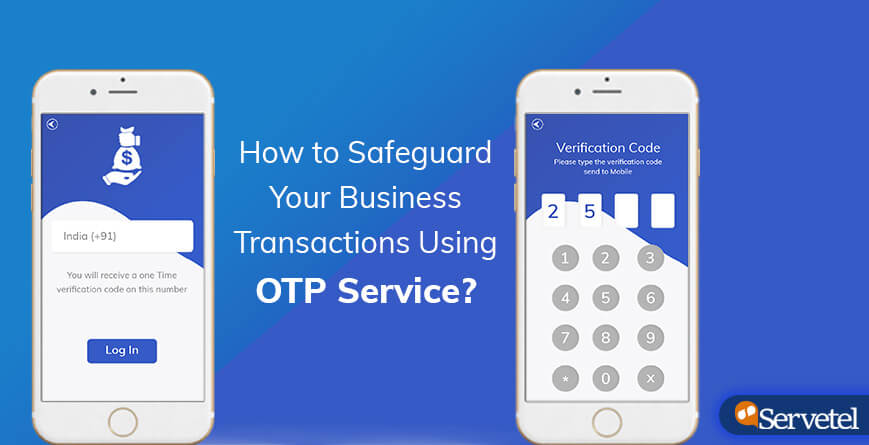According to the 2017 Data Breach Investigations Report released by Verizon,
81% hacking-related breaches leveraged either stolen or weak passwords.
The report further adds,
Social engineering is a common means for cybercriminals to establish a foothold. And employees are making this further easy by using easy-to-crack passwords. Users and IT departments are even often guilty of not changing the default passwords that devices come with and can be easily looked up online.
The growing instances of social engineering attacks depict ineffectiveness of user-generated passwords to safeguard sensitive customer data and business transactions. In addition to making customers abandon a business or brand, these attacks often make businesses incur financial and reputation losses. Thus, your business must implement a robust alternative to protect various business transactions continuously.
To enhance transaction security and prevent social engineering attacks businesses these days are switching to one-time password from user-generated passwords.
What is One Time Password?
Technopedia.com explains One Time Password (OTP) as a secure way to provide access to an application or perform a transaction only one time. Unlike user-generated passwords, an OTP is valid only for a single transaction. The OTP expires automatically after a few minutes after the user has utilized it.
The OTP service helps your business to send one-time passwords to customers in various formats – emails, text messages and voice messages. Your business can trigger the OTP automatically based on the request made by the customers during the transaction or login process. These OTPs are hard to crack and hack due to the randomly generated string of alphanumeric characters.
Businesses can implement transaction security by integrating the OTP SMS API with the website, mobile app, and third-party applications. In addition to delivering OTPs through SMS and voice platforms, you can track OTP delivery status – successful, failed and reattempted based on automated analytics reports. The OTP services help your enterprise to safeguard business transactions in several ways.
7 Ways OTP Service Helps Your Enterprise to Keep Business Transactions Secure
1. Overcome Shortcomings of Static Passwords and PINs
Most customers still perform financial transactions and share sensitive information using static passwords or personal identification numbers (PINs). But they often fail to ensure that passwords used are difficult to guess or crack. They further keep the financial transaction and sensitive information vulnerable to targeted security attacks by using the same password for multiple transactions or login session.
Many cybersecurity experts these days advise customers never to use certain passwords which are dangerously easy-to-guess. OTPs help your business to protect both customer data and digital transactions by overcoming shortcomings of static passwords or PINs. Many cybersecurity experts these days advise businesses to improve data security and privacy by replacing static passwords/PINs with dynamic and transaction-specific passwords. The OTP service helps your customers use dynamic passwords and implement two-factor authentication.
2. Prevent Password-Based Security Attacks
The easy-to-guess nature of user-generated passwords makes it easier for cybercriminals to execute security attacks like password sniffing, brute force attack and dictionary attacks. The OTP services make it difficult for cybercriminals to guess passwords using mathematical algorithms.
The algorithm used to create OTPs generates temporary passwords randomly by combining numeric or alphanumeric characters. Hence, it becomes easier for your business to combat various types of password-based security attacks successfully.
3. Keeps Password Valid for a Few Minutes
Employees impact the security of business transactions and customer data adversely by using the same password for multiple transactions. Unlike user-generated passwords, an OTP is valid only for a single transaction or login session.
It expires automatically after a short period despite being used or not used by the customer. Time synchronization techniques are used to expire these passwords after a short period automatically. After the password expires, the customer must request a new OTP to complete or repeat the transaction.
4. Send Critical Information Timely and Securely
Your business has the option to send OTP to customers through multiple communication channels – text messages, emails or voice. But it sends the code to an email and mobile number both to strengthen the security of the registration process.
These codes are sent in a time gap of fewer than 10 seconds using the fast and secure SMS APIs. These APIs can be integrated with any application to trigger OTPs at important checkpoints for a secure and reliable access.
5. Authenticate a Variety of Business Transactions
OTP services have replaced static passwords with dynamic ones. B2B and B2C businesses are using this service to safeguard a variety of transactions – eCommerce purchases, digital payment, account reactivation, account deletion and password resets.
Enterprises are leveraging the difficult-to-crack feature of OTPs to enhance customer data security, eliminate chances of data loss, and protect digital transactions.
6. Implement Two-Factor Authorization
Two-factor authentications safeguard various business transactions by replacing user-generated passwords with OTP. The security technique enables your business to cross-check the identity of a customer by sending OTP to his or her registered mobile number.
It requires the agent to validate his or her identity by submitting the OTP after logging in to the online account using the existing user name and password. In addition to protecting business transactions, the two-factor authorization adds an extra layer of security to the website, mobile apps or enterprise software solution.
7. Choose from Multiple OTP Generation Approaches
The OTP service providers generate the password using advanced algorithms. The algorithm keeps the password difficult-to-guess by using alphanumeric or numeric patterns. Some providers even allow your business to choose from various approaches for OTP generation.
For instance, you can opt for time-synchronization based approach to make the dynamic password expire in a specific amount of time. Likewise, you can use different algorithms to generate the password based on the previous OTPs sent to the customer. The complex algorithms further allow you to trigger OTPs based on specific conditions.
Moreover, a business can leverage OTP service to deliver a one-time password to customers over SMS and voice platforms in 10 seconds. They can further generate custom OTP messages and track OTP delivery status without putting extra time and effort. A reliable OTP service helps your business to prevent reputational and financial losses by keeping business transactions secure and combating password-based security attacks.
Want to know more? Call us at 1800-120-4132.

















